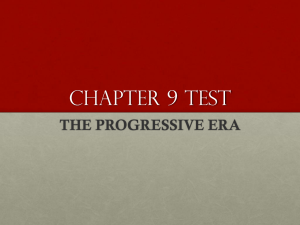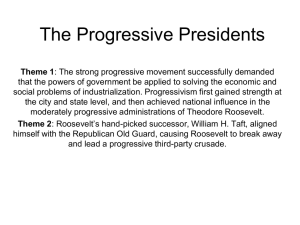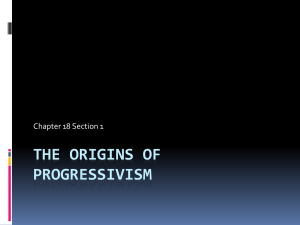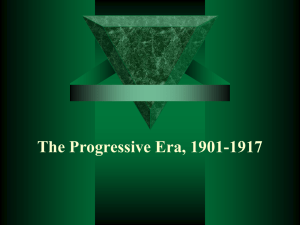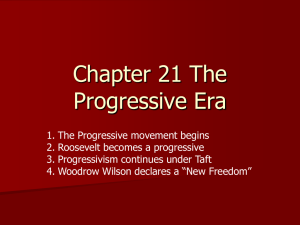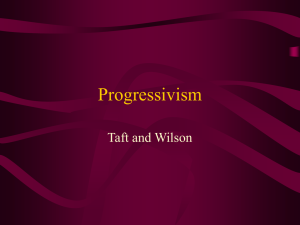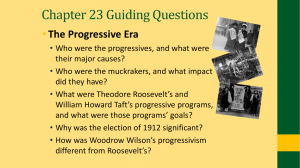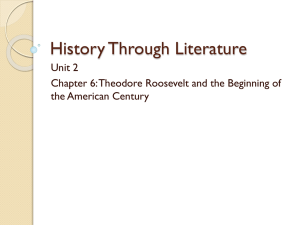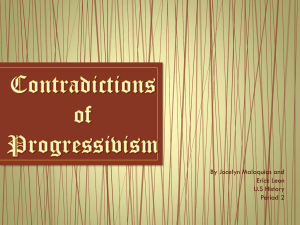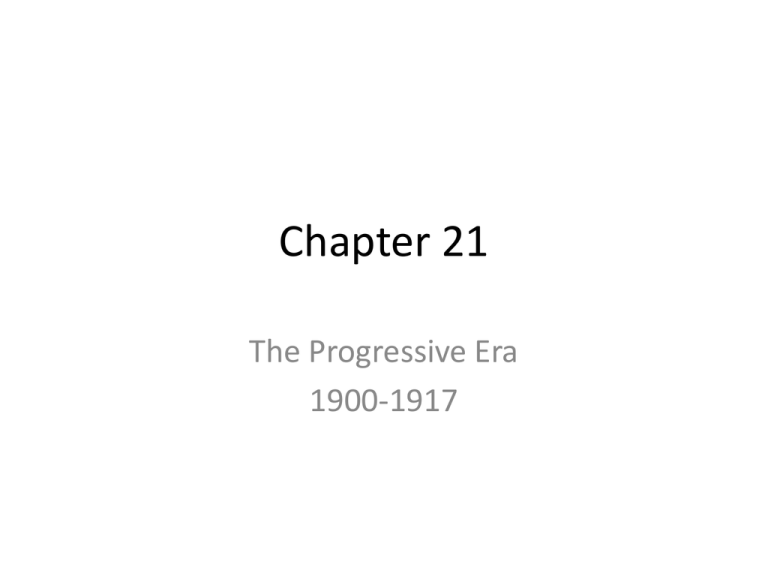
Chapter 21
The Progressive Era
1900-1917
Introduction
• This chapter covers:
– Economic and social changes
– Problems caused by industrialization and
urbanization
– How the Progressive reform movement emerged
to wrestle with these problems/changes
Introduction (cont.)
• An example:
– The unsafe and unsanitary conditions in which
millions of workers labored produced tragedies
• Such as the 1911 Triangle Shirtwaist fire in which 141
sweatshop employees died
– After the Fire, aroused Progressives convinced
New York State to enact many labor protective
laws
Introduction (cont.)
• 1.) How did intellectuals and writers prepare the way
for Progressive reform?
• 2.) What conditions in the cities and states bothered
Progressives, and what did they hope to do about
them?
• 3.) How did Progressive reform reach national
politics, and which leaders and issues were involved?
Introduction (cont.)
• 4.) What impact did Progressive reform have
on the lives of women, immigrants, the urban
poor, and African-Americans?
• 5.) Did progressivism alter people’s views on
the proper role of govt. in America’s society
and economy?
Progressives and Their Ideas
• The Many Faces of Progressivism
– Progressive reformers included much of the new urban
middle class
• Mostly white, native-born Protestants
– Middle-class women (often college educated)
• Working through settlement houses and private organizations
(National Consumers’ League)
– Urban, immigrant political machines and workers began to
demand improved labor conditions
The Many Faces of Progressivism
(cont.)
• The Progressives were strongest in the cities
• Attracted support from middle-class
professionals and intellectuals
• Most Progressives accepted the capitalist
system
– They merely wanted to reform the worst
abuses that had developed under it
The Many Faces of Progressivism
(cont.)
• There was never 1 unified movement, but
many different groups of reformers
– Some preached regulation of big businesses
– Others concentrated on passing laws to protect
workers
– Others thought the way to cure social ills was to
curtail immigration
The Many Faces of Progressivism
(cont.)
• Progressives generally attempted to be
“scientific” in their approach
– Backed their demands for change with scholarly
studies of deplorable conditions to be remedied
Intellectuals Offer New Social
Views
• Many intellectuals criticized unrestrained, brutal
capitalist competition
• They called for an activist govt. that would regulate
business practices and protect the economically
vulnerable
–
–
–
–
Thorstein Veblen (economist)
Herbert Croly (journalist)
William James (pragmatic philosopher)
Jane Addams (settlement-house leader)
Intellectuals Offer New Social
Views (cont.)
• New educational and legal ideas paved the way for
the Progressive movement
– John Dewey
• Preached that schools must foster in students respect for the
values of democracy and cooperation
– Oliver Wendell Holmes, Jr.
• Supreme Court Justice
• Attacked conservative judges for being guided entirely by legal
precedent
• He insisted that the “law must evolve as society changes”
Dewey and Holmes
Novelists, Journalists,
and Artists Spotlight Social Problems
• Muckraking journalists and novelists played an
important role in stimulating the Progressive
movement by exposing to middle-class
Americans political corruption and corporate
wrongdoing
Novelists, Journalists,
and Artists Spotlight Social Problems
(cont.)
• Lincoln Steffens
– Wrote about urban
political machines and
bosses
• Ida Tarbell
– Cutthroat competitive
practices of Standard
Oil Company
Novelists, Journalists,
and Artists Spotlight Social Problems
(cont.)
• Magazines such as McClure’s and Collier’s
specialized in muckraking articles
• Novelists Frank Norris in The Octopus and
Theodore Dreiser in The Financier also told
tales of business abuses and political
corruption
Novelists, Journalists,
and Artists Spotlight Social Problems
(cont.)
• “Ashcan School” artists and photographers
such as Lewis Hine depicted the harsh world
of the immigrants, factory workers and child
laborers
State and Local Progressivism
• Reforming the Political Process
– The earliest signs of the Progressive movement appeared
in cities where municipal reformers battled corrupt
political machines
• These cities elected activist mayors dedicated to change
– Hazen Pingree of Detroit
– Samuel Jones of Toledo
– Reform mayors generally:
• brought honesty to municipal govt.
• Provided city dwellers with improved municipal services and
facilities
• Forced transportation and utility companies to lower rates and pay
their fair share of taxes
Reforming the Political Process
(cont.)
• Other municipal reformers experimented with
commission and city-manager forms of govt.
Reforming the Political Process
(cont.)
• The reform efforts soon moved up to state govt.
• Progressives attempted to democratize politics by
establishing:
–
–
–
–
–
secret balloting
direct primary
initiative
referendum
recall
• In practice these measures fell short of producing the
democratic results that the Progressives had hoped
Regulating Business, Protecting
Workers
• After 1900, the growth of huge business
corporation speeded up
– Example: in 1901 J.P. Morgan consolidated
hundreds of independent steel makers to form the
U.S. Steel Company which controlled 80% of
production in the nation
• This trend alarmed many Americans
Regulating Business, Protecting
Workers (cont.)
• The real wages of industrial laborers rose after
1900
– They were still so inadequate that in many families
the mothers and children had to work to make
ends meet
• In 1910 at least 1.6 million youngsters between 10-16
years old worked full-time
Regulating Business, Protecting
Workers (cont.)
• Industrial laborers spent on average 9 1/2
hours a day in mills and shops
– Often in hazardous conditions (both in health and
safety)
• Employers tried to get even more work out of
their employees
– Frederick W. Taylor and other efficiency experts
Regulating Business, Protecting
Workers (cont.)
• Under Progressive
influence, state govts.
started to impose
regulation on
railroads, mines, and
other business
corporation
• The pioneer was WI
under Governor
Robert LaFollette
Regulating Business, Protecting
Workers (cont.)
• Between 1901 and 1906 LaFollette convinced the
legislature to:
– create a state railroad commission
– increase corporate taxes
– limit business contributions to political campaigns
• He and the legislature also introduced political
reforms such as the direct primary
• “Wisconsin Idea”
Regulating Business, Protecting
Workers (cont.)
• Other states passed important labor laws as well:
– Maximum # of hours per workday for female employees
• Oregon’s 10-hour law
– Factory safety codes
• Such as the one enacted in NY after the Triangle Shirtwaist fire
– Workers’ compensation acts
– Bans on child labor
Making Cities More Livable
• Cities grew rapidly between 1900 and 1920 as
rural Americans and millions of immigrants
moved into them
• Overwhelmed and often corrupt municipal
govts. failed to provide the newcomers with
adequate services and public facilities
Making Cities More Livable (cont.)
• Progressive reformers began to beautify cities
with:
– more parks and playgrounds
– Broad boulevards
– Impressive municipal buildings
• State legislatures passed housing coded to
upgrade living conditions in tenements and
slum neighborhoods
Making Cities More Livable (cont.)
• Cities and states improved:
– Garbage collection
– Street cleaning
– Water and sewer systems
• And required higher standards:
– of cleanliness
– Of quality form sellers of food and milk
• These Progressive reforms significantly decreased
infant mortality and tuberculosis deaths
Making Cities More Livable (cont.)
• There were also attempts to reduce air
pollution
– Business fought these vigorously
– The continued reliance on coal as the chief energy
source left cities smoky and sooty
Progressivism and Social Control
• Moral Control in the Cities
– Some reformers tried to guard morality by
inducing cities to censor movies and outlaw
prostitution
– A wave of hysteria over prostitution led to the
passage of the federal Mann Act (1910) and the
close of red-light districts
Battling Alcohol and Drugs
• Prohibition became the biggest moral crusade of the
Progressive Era
• Anti-Saloon League, Women’s Christian Temperance
Union, various church groups
• Many localities enacted bans on liquor sales
• The national prohibition movement grew stronger
Battling Alcohol and Drugs (cont.)
• Progressives also campaigned against the thenwidespread use of such addictive drugs as morphine,
heroin, and cocaine
• Their efforts led to the passage of the federal
Narcotics Act in 1914
– Outlawed the distribution of heroin, morphine, and
cocaine except by doctors’ prescriptions
Immigration Restriction and
Eugenics
• Between 1900-1917, 17 million immigrants
entered the U.S.A.
– Mostly from southern and eastern Europe
• Many native-born Americans became fearful
– They often believed that immigrants caused
poverty and immorality
Immigration Restriction and
Eugenics (cont.)
• Immigration Restriction League
– 1894
– Founded by Senator Henry Cabot Lodge and other
prominent Bostonians
• In 1971 Congress excluded illiterate
immigrants
– Over President Wilson’s veto
Immigration Restriction and
Eugenics (cont.)
• Eugenicists claimed that humans and society could
be improved by controlled breeding
• Some states passed laws allowing forced sterilization
of criminals, mentally deficient persons, and sex
offenders
• Pseudo-scientific racism was spewed by some socalled progressive writers
– Madison Grant--The Passing of the Great Race (1916)
African-Americans After
Reconstruction
• After Reconstruction, white Democrats in the South
increasingly deprived black southerners of the right
to vote
• At first the whites used intimidation and terror
• After 1890 they used more effective means:
– Poll taxes
– Literacy tests
– Grandfather clauses
African-Americans After
Reconstruction (cont.)
• Southern blacks also were victimized by:
– segregation laws
– the convict-lease system
– Lynching
• Some southern Populists attempted to combat
prejudice
– Encouraged white and black farmers to unite against their
exploiters
• The Southern Democratic elite purposely inflamed
racial antagonism to keep poor farmers divided
African-Americans After
Reconstruction (cont.)
• The federal govt. did nothing to protect black
rights
• The Supreme Court gave it stamp of approval
to segregated but equal facilities in Plessy v.
Ferguson (1896)
– Plessy summary
• It also upheld poll taxes and literacy tests in
1898
African-Americans After
Reconstruction (cont.)
• Blacks responded to these abuses in several ways
• Some fled the South only to find de facto segregation
in the North
• Booker T. Washington advised fellow blacks to accept
their second-class status for a time and concentrate
on getting ahead economically and educationally
• Accept the South’s Jim Crow and disenfranchisement
laws
African-Americans After
Reconstruction (cont.)
• Abolitionist Frederick Douglass still called on
blacks to demand full equality
• The South became a one-party region always
controlled by the Democrats
– With the disenfranchisement of blacks
– The defeat of southern populism
African-Americans After
Reconstruction (cont.)
• The South became a one-party region always
controlled by the Democrats
– With the disenfranchisement of blacks
– The defeat of southern populism
Racism and Progressivism
• In 1900 the majority of the 10 million AfricanAmericans were still in the rural South
– Most as sharecroppers
• Many began to migrate to cities and to the
North
– Escape poverty, disenfranchisement, Jim Crow
laws, and violence
Racism and Progressivism (cont.)
• In the North they encountered de factor segregation
and discrimination
– Under these difficult circumstances, African-Americans
developed their own communities and culture
• Racism in American society reached a peak during
the Progressive Era
• Many progressives either ignored racial
discrimination or were themselves racists
Racism and Progressivism (cont.)
• Southern Progressives combined advocacy of
economic and political reform with vicious attacks on
African-Americans
– James K. Vardaman and Ben Tillman
• The 2 Progressive-reformer presidents of the era
compiled sorry records on racial justice
– Theodore Roosevelt
– Woodrow Wilson
Racism and Progressivism (cont.)
• Roosevelt ordered the unwarranted
dishonorable discharge of an entire regiment
of African-American soldiers in the
Brownsville, Texas, incident
• Wilson praised the racist movie Birth of a
Nation and condoned the introduction of
racial segregation in all federal govt. agencies
and departments
Racism and Progressivism (cont.)
• Some white progressives decried racial
injustice and helped found the National
Association for the Advancement of Colored
People (NAACP)
– Lillian Wald and Mary White
African-American Leaders Organize
Against Racism (cont.)
• Northern African-Americans intellectuals and
professionals urged African-Americans to fight
for economic, political, and educational
equality
– William Monroe Trotter
– Ida Wells-Barnett
– W.E.B. DuBois
Trotter, Wells, DuBois
African-American Leaders Organize
Against Racism (cont.)
• Niagara Movement
– 1905
– DuBois and other African-American critics of Washington
formed
• In 1909, DuBois and other members of the Niagara
Movement joined with white Progressives in
organizing the NAACP
– Rejected Booker T. Washington’s accommodations advice
– Began the long fight for racial justice
Revival of the WomanSuffrage Movement
• A new group of feminists
emerged to revitalize the
women’s movement
• Carrie Chapman Catt
– Became president of the
National American Woman
Suffrage Association in
1900
Revival of the Woman-Suffrage
Movement (cont.)
• Catt led her members in lobbying, distributing
literature, and demonstrating
• They convinced several states to grant women
the vote
Revival of the WomanSuffrage Movement (cont.)
• Alice Paul
– National Woman’s
Party
– Bring direct pressure
on the federal govt. for
passage of a
constitutional
amendment
enfranchising women
Enlarging “Woman’s Sphere”
• Feminists challenged the assumption that the only
proper roles for women were those of wife, mother,
and homemaker
– Florence Kelley, Alice Hamilton, Margaret Sanger
• Led the Progressives drives to:
– abolish child labor
– Protect the health of workers and consumers
– Establish birth-control clinics
Workers Organize: Socialism
Advances
• To improve their working environment,
workers kept trying to unionize
• Their right to strike was frequently curtailed
by conservative court decisions
– Employers often hired recent immigrants as scabs
when employees went on strike
Workers Organize: Socialism
Advances (cont.)
• American Federal of Labor (AFL) grew primarily in the
skilled trades
• Most factory workers were unorganized early on
• 2 unions attempted to help semiskilled and unskilled
workers:
– International Ladies’ Garment Workers’ Union
• Led successful strikes in the needle trades
– Industrial Workers of the World (IWW)
Workers Organize: Socialism
Advances (cont.)
• The IWW singed up western miners,
lumberjacks, and migratory farm workers
• IWW won a major strike in 1912 in the textile
mills of MA
• Govt. repression of the IWW during WWI
caused the decline of the organization
Workers Organize: Socialism
Advances (cont.)
• The Socialist Party of
America was gaining
followers
– Hoped to end
capitalism through the
ballot box rather than
revolution
– Eugene Debs
• Ran for president in
1912 and received
900,000 votes
National Progressivism--Phase I:
Roosevelt and Taft, 1901-1913
• Roosevelt’s Path to
the White House
– Became President in
1901 after McKinley
was assassinated
– Became the first
Progressive president
Roosevelt’s Path to the White
House (cont.)
• A believer in strong executive leadership,
Roosevelt enlarged the powers of the
presidency
• Turned the office into both an effective forum
and the center of legislative initiative
Labor Disputes, Trustbusting, and
Railroad Regulation
• Unlike earlier presidents who used troops to
break strikes, Roosevelt like to use arbitration
– Example: coal miners’ strike of 1902
• Management and the United Mine Workers used
arbitration by a commission Roosevelt appointed
• The commission granted the miners increased pay and
reduced hours
Labor Disputes, Trustbusting, and
Railroad Regulation (cont.)
• Roosevelt did not want to attack big business
• He preached that corporate giants must obey the law
and serve the public interest
• He prosecuted firms that he believed violated the
Sherman Anti-Trust Act
– Northern Securities Company
• Despite his trustbusting, he stayed on good terms
with big business
Labor Disputes, Trustbusting, and
Railroad Regulation (cont.)
• 1904 election, Roosevelt easily won over
conservative Democratic opponent, Alton B. Parker
• Hepburn Act
– 1906
– Strengthened corporate regulation
– Gave the Interstate Commerce Commission (ICC) the
power to set maximum railroad rates and examine
railroads’ financial records
Consumer Protection
• Responding to public concern generated by
Upton Sinclair’s The Jungle, Roosevelt
persuaded Congress to pass the Pure Food
and Drug Act (1906) and the Meat Inspection
Act (1906)
– Pure Food and Drug Act
– Meat Inspection Act
Environmentalism Progressive
Style
• Roosevelt made his most enduring reforms in
conservation
• Years of exploitation for private gain had damaged
and depleted America’s natural environment
• By the 1890’s, land use had become a political issue
– Putting business interests, preservationists, and
conservationists against each other
Environmentalism Progressive
Style (cont.)
• Entrepreneurs wanted to continue unrestricted
development for private enrichment
• Preservationists wished to save large wilderness
tracts for their beauty and spiritual worth
– John Muir and the Sierra Club
• Conservation movement sought govt. scientific
management to make the public domain best serve
the resource needs of the nation now and in the
future
– Gifford Pinchot (Roosevelt’s Forest Service chief)
Environmentalism Progressive
Style (cont.)
• At times, the preservationists and the
conservationists engaged in bitter combat
– Example: the 1913 fight over the building of a
dam in a beautiful part of Yosemite National Park
to provide water and hydroelectric power for San
Francisco
Environmentalism Progressive
Style (cont.)
• Roosevelt used the presidency to popularize both
conservation and preservation
• Newlands Act of 1902
– Important in the economic development of the West
• Set aside about 200 million acres of forest and
mineral-rich lands for government-managed use
rather than sale to business
• Antiquities Act (1906)
– National historical landmarks
• Established national parks
Environmentalism Progressive
Style (cont.)
• In 1916, during Wilson’s administration,
Congress established the National Park Service
to protect and run the national historic sites,
monuments, and parks
Taft in the White House,
1909-1913
• William Howard Taft was
Roosevelt’s secretary of
war
• Won 1908 election over
William Jennings Bryan
• Pledged to continue
Roosevelt’s Square Deal
Taft in the White House, 19091913 (cont.)
• Taft prosecuted more trusts than Roosevelt
had
• Taft, though, lacked Roosevelt’s activism, flair
for publicity, and political skills
Taft in the White House, 19091913 (cont.)
• In the fight shaping up between the progressive and
conservative wings of the Republican party, Taft
sided with the conservatives
• Taft alienated progressive Republicans by:
– Signing the Payne-Aldrich bill
• Raised tariffs
– Fired conservationist Gifford Pinchot
Taft in the White House, 19091913 (cont.)
• Progressive Republicans joined with Roosevelt
in denouncing the conservatives and
campaigned for revived Progressive reform
The Four-Way Election of 1912
• In 1912, Theodore Roosevelt challenged Taft for the
Republican nomination
• The convention chose Taft
• Roosevelt’s backers walked out and founded the rival
Progressive Party and nominated Roosevelt
• The Democrats nominated Woodrow Wilson
• Socialists nominated Eugene Debs
The Four-Way Election of 1912
(cont.)
• “New Nationalism”
– Roosevelt’s platform
– Accept big business as inevitable
– But build a powerful activist federal govt. to regulate the
corporate giants
• New Freedom
– Wilson’s platform
– Rejected big govt. in Washington
– Called for a return to an economy composed of small,
competing enterprise
The Four-Way Election of
1912 (cont.)
• Wilson won the White
House
• Democrats also won
Congress
National Progressivism--Phase II:
Woodrow Wilson, 1913-1917
• Introduction
– Woodrow Wilson had been
a political science professor
and president of Princeton
University
– Then he became Governor
of NJ
– Skilled and flexible
politician
– But sometimes was
intolerant and selfrighteous
Introduction (cont.)
• Despite Wilson’s stated preference for small
business and limited govt. in the 1912
election, as president he led the effort to “use
govt. to address the problems of the new
corporate order.”
Tariff and Banking Reform
• Wilson convinced Congress to pass the 1913
Underwood-Simmons Tariff
– Reduced import duties by roughly 15%
• Federal Reserve Act
– 1913
– Kept banking a private enterprise but imposed public
regulation over it
– 12 regional Federal Reserve banks
• Empowered to expand the nation’s credit and money supply
• Could issue Federal Reserve notes
• Under the supervision of the Federal Reserve Board
– Appointed by the president
Regulating Business; Aiding
Workers and Farmers
• Federal Trade Commission
– 1914
– Federal regulatory agency
– Power to uncover unfair
methods of business
competition
– Then issue cease and desist
orders against perpetrators
Regulating Business; Aiding
Workers and Farmers (cont.)
• Clayton Act
– 1914
– Supplemented the vague and general Sherman
Anti-Trust Act
– Defined and listed specific illegal practices
Regulating Business; Aiding
Workers and Farmers (cont.)
• Wilson endorsed the clause in the Clayton Act
exempting union strikes, boycotts, and
picketing from prosecution under the antitrust
laws
Regulating Business; Aiding
Workers and Farmers (cont.)
• He also signed the following into law:
– Keating-Owen Act
• 1916
• Child labor law with interstate commerce
• Later declared unconstitutional
– Adamson Act
• 1916
• 8-hour day for railroad workers
– Workmen’s Compensation Act
• For federal employees
– Legislation to help farmers obtain loans at lower interest
rates
Progressivism and the
Constitution
• Wilson nominated to the
Supreme Court
Progressive Jewish
attorney Louis Brandeis
• Conservatives and antiSemites objected
• Wilson persuaded the
Senate to confirm
Brandeis
Progressivism and the Constitution
(cont.)
• The Progressive Era saw 4 amendments added to the
U.S. Constitution:
– 16th (1913)
• Authorized a federal income tax
– 17th (1913)
• Popular or direct election of senators
– 18th (1919)
• Prohibition
– 19th (1920)
• Women suffrage
1916: Wilson Edges Out
Hughes
• Democrats renominated Wilson
• Republicans ran Charles Evans Hughes
• Wilson won in a close race
Conclusion
• Some Progressive reforms did less good than their
backers had hoped
• Progressivism had some repressive and intolerant
elements
• The movement as a whole left a legacy of govt.
intervention to:
– regulate destructive corporate practices
– protect the economically vulnerable
– improved social problems arising from industrialization
• It was a precedent on which the New Deal would
later build

